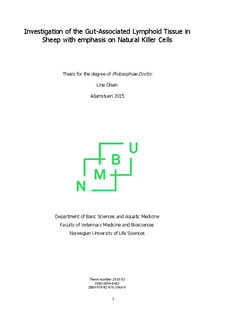| dc.contributor.advisor | Espenes, Arild | |
| dc.contributor.advisor | Storset, Anne | |
| dc.contributor.author | Olsen, Line | |
| dc.date.accessioned | 2017-07-04T11:57:42Z | |
| dc.date.available | 2017-07-04T11:57:42Z | |
| dc.date.issued | 2017-07-04 | |
| dc.identifier.isbn | 978-82-575-1960-5 | |
| dc.identifier.issn | 1894-6402 | |
| dc.identifier.uri | http://hdl.handle.net/11250/2447755 | |
| dc.description.abstract | The gut-associated lymphoid tissue (GALT) of sheep has been investigated for decades, and several immune cells receding within these structures have been described. The GALT of sheep has specialized compartments described to contain myeloid and lymphoid cells. The newly developed antibody against ovine NCR1 has been shown to label lymphocytes with conventional attributes of NK cells. However, the precise localization, phenotype and activation of NCR1+ cells in the small and large intestinal lymphoid compartments remain unknown.
Investigations presented in this thesis were done using different types of immuno-labelling on tissue sections and in flow cytometry. The NCR1+ cells were detected in the gut of foetuses from day 70 in the gestation, and these cells resided in compartments where T cells usually are seen; the inter-follicular area, dome and lamina propria. The NCR1+ cells of the ovine foetal gut showed an increasing fraction of c-kit expression in the last period before birth. The localization of NCR1+ cells described in the three papers is stable in foetus, normal unchallenged lambs and during cryptosporidiosis. The studies have revealed two separate phenotypic subtypes, both exhibiting characteristics of conventional NK cells. However, based on the new classification of innate lymphoid cells described in mouse and human, some of the NCR1+ cells could be grouped as a subtype featuring regulatory and less cytotoxic functions, designated ILC22. From the youngest group of foetuses investigated we found NCR1+ cells to proliferate, whereas this fraction of cells decreased to a minimum and were almost absent in the juvenile lambs. During an experimental infection with
Cryptosporidium parvum we found the NCR1+ cells to be faithful to their compartmentalization and showed an elevation of activation status.
The results presented in this thesis may be useful for comparative considerations and for general understanding of NCR1+ cells in the sheep. It may be a basis for further investigations of the GALT and immune responses in the gut of sheep. | nb_NO |
| dc.description.abstract | Tarmassosiert lymfatisk vev har vært undersøkt i flere
tiår, og dette lymfatiske vevet har spesialiserte områder, inneholdende myeloide og lymfoide celler. Det nylige utviklede antistoffet mot sau NCR1 er blitt vist å merke lymfocytter med klassiske karakteristika kjent for dreper(NK) celler. Det er imidlertid ennå ikke blitt beskrevet lokalisasjon, fenotype eller aktiveringsstatus hos NCR1+ celler i tynn- og tykktarmens lymfoide områder hos drøvtyggere.
Undersøkelser som er presentert i denne avhandlingen ble gjort ved hjelp av ulike typer immunmerking på snitt av vev og i væskestrømcytometri. NCR1+ celler ble funnet i tarm hos fostre fra 70 dager i drektigheten og ble funnet i områder hvor T celler vanligvis er lokalisert; interfollikulær områder, dome og lamina propria. NCR1+ celler som ble funnet i sauefosterets tarm viste å ha økende uttrykk av c-kit i den siste perioden før fødsel. Studiene har avslørt to separate fenotypiske subtyper, der begge innehar typiske karakteristiske trekk av klassiske NK celler. Det er imidlertid kommet en ny klassifisering av medfødte lymfoide celler, som kan føre til at noen av de NCR1+ cellene kan bli klassifisert som en subtype vist å være mer regulatorisk og mindre cytotoksisk, kalt ILC22. Vi fant prolifererende NCR1+ celler i de yngste fostrene, der andelen av disse sank til et minimum mot fødsel og var nesten fraværende i unge lam. Lokaliseringen av NCR1+ celler beskrevet i de tre artiklene er stabil i fostre, normale friske lam og i cryptosporidieinfiserte lam. I løpet av en eksperimentell infeksjon med Cryptosporidium parvum fant vi at de NCR1+ cellene viste uendret lokalisasjon i tarmen og en økning av aktiveringsstatus.
Resultatene som er presentert i denne avhandlingen kan være nyttige for komparative betraktninger og for å få en generell forståelse av NCR1+ celler i sau. Det kan være et grunnlag for videre undersøkelser hos tarmassosiert vev og immunrespons hos sau. | nb_NO |
| dc.language.iso | eng | nb_NO |
| dc.publisher | Norwegian University of Life Sciences, Ås | |
| dc.relation.ispartofseries | PhD Thesis;2015:52 | |
| dc.title | Investigation of the gut-associated lymphoid tissue in sheep with emphasis on natural killer cells | nb_NO |
| dc.type | Doctoral thesis | nb_NO |
| dc.source.pagenumber | 1 b. (flere pag.) | nb_NO |
